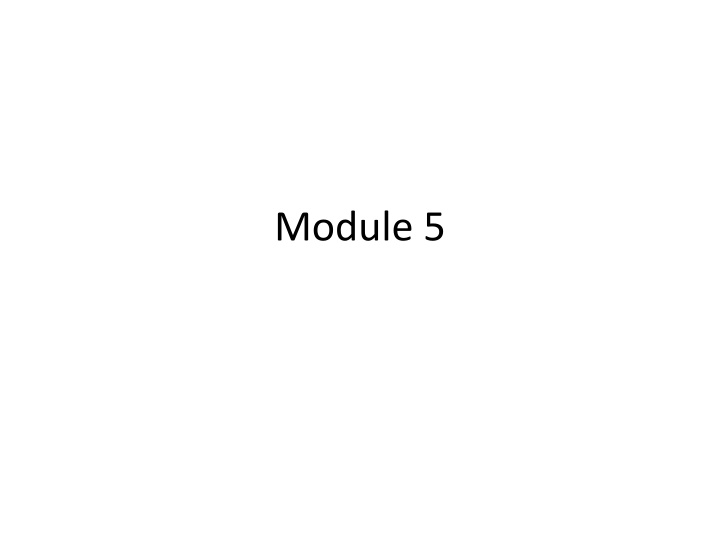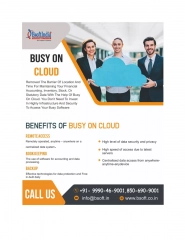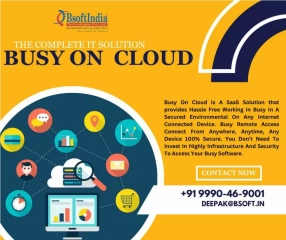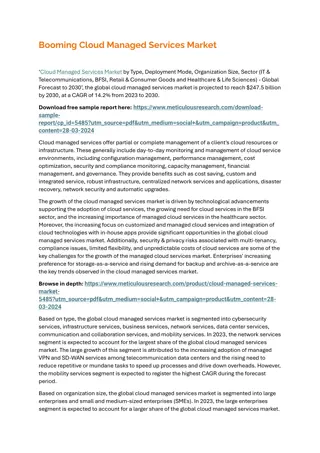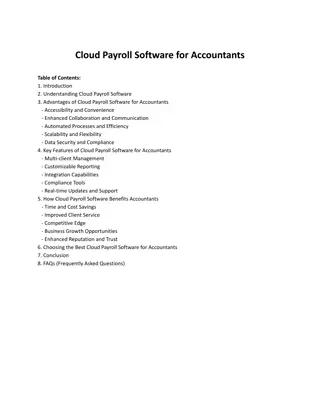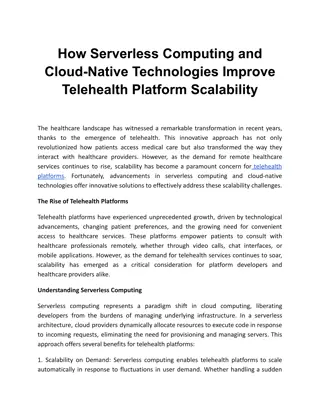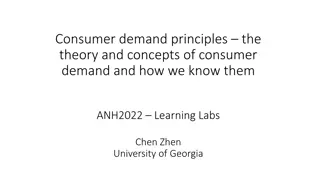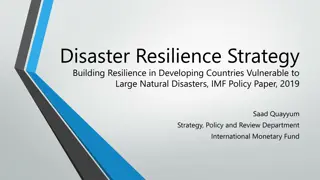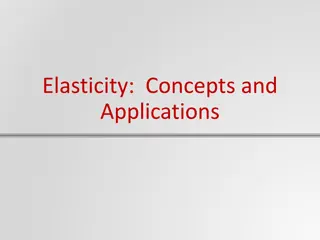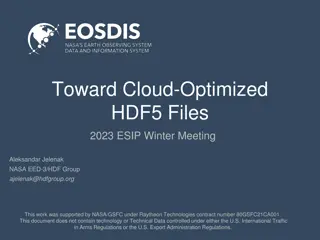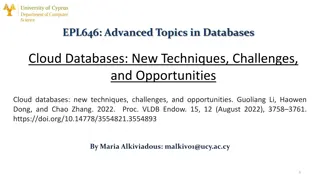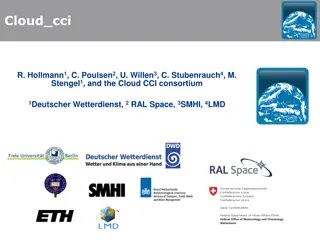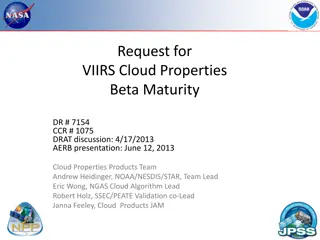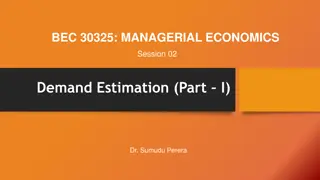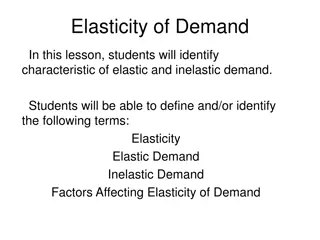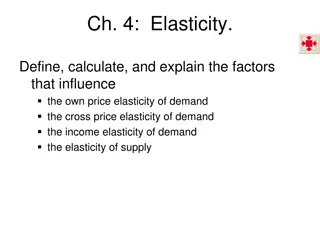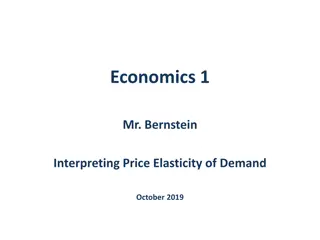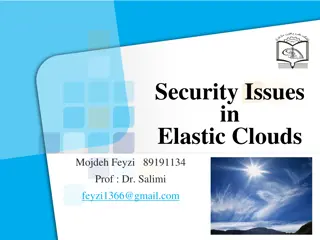Cloud-Based Software: Scalability, Elasticity, Resilience
Cloud-based software offers scalability to handle increasing user loads, elasticity for dynamic server adjustments, and resilience for server failures. Virtualization and containers play a key role in creating virtual servers on cloud platforms.
Download Presentation

Please find below an Image/Link to download the presentation.
The content on the website is provided AS IS for your information and personal use only. It may not be sold, licensed, or shared on other websites without obtaining consent from the author.If you encounter any issues during the download, it is possible that the publisher has removed the file from their server.
You are allowed to download the files provided on this website for personal or commercial use, subject to the condition that they are used lawfully. All files are the property of their respective owners.
The content on the website is provided AS IS for your information and personal use only. It may not be sold, licensed, or shared on other websites without obtaining consent from the author.
E N D
Presentation Transcript
1 Cloud-Based Software The cloud servers that you rent can be started up and shut down as demand changes. This means that software that runs on the cloud can be scalable,elastic, and resilient (Figure 5.1.Scalability, elasticity, and resilience are the fundamental differences between cloud-based systems and those hosted on dedicated servers.
Scalability reflects the ability of your software to cope with increasing numbers of users. As the load on your software increases, the software automatically adapts to maintain the system performance and response time. Systems can be scaled by adding new servers or by migrating to a more powerful server. If a more powerful server is used, this is called scaling up. If new servers of the same type are added, this is called scaling out. If your software is scaled out, copies of your software are created and executed on the additional servers.
Elasticity is related to scalability but allows for scaling down as well as scaling up. That is, you can monitor the demand on your application and add or remove servers dynamically as the number of users changes. This means that you pay for only the servers you need, when you need them. Resilience means that you can design your software architecture to tolerate server failures. You can make several copies of your software available concurrently. If one of these fails, the others continue to provide a service. You can cope with the failure of a cloud data center by locating redundant servers in different places.
1.1 Virtualization and containers All cloud servers are virtual servers. A virtual server runs on an underlying physical computer and is made up of an operating system plus a set of software packages that provide the server functionality required. The general idea is that a virtual server is a stand-alone system that can run on any hardware in the cloud. This run anywhere characteristic is possible because the virtual server no external dependencies.
Virtual machines (VMs), running on physical server hardware, can be used to implement virtual servers (Figure 5.2). The details are complex, but you can think of the hypervisor as providing a hardware emulation that simulates the operation of the underlying hardware. Several of these hardware emulators share the physical hardware and run in parallel. You can run an operating system and then install server software on each hardware emulator.
In many cases, you dont really need the generality of a virtual machine. If you are running a cloud-based system with many instances of applications or services, these all use the same operating system. To cater to this situation, a simpler, lightweight, virtualization technology called containers may be used. VIRTUALMACHINE VS CONTAINERS Using containers dramatically speeds up the process of deploying virtual servers on the cloud. Containers are usually megabytes in size, whereas VMs are gigabytes. Containers can be started up and shut down in a few seconds rather than the few minutes required for a VM. Many companies that provide cloud-based software have now switched from VMs to containers because containers are faster to load and less demanding of machine resources. Containers are an operating system virtualization technology that allows independent servers to share a single operating system. They are particularly useful for providing isolated application services where each user sees their own version of an application.
The advantage of using a virtual machine to implement virtual servers is that you have exactly the same hardware platform as a physical server. You can therefore run different operating systems on virtual machines that are hosted on the same computer. For example, Figure 5.2 shows that Linux and Windows can run concurrently on separate VMs. You may want to do this so that you can run software that is available for only one particular operating system.
An open-source project called Docker provided a standard means of container management that is fast and easy to use. Docker is now the most widely used container technology, so I discuss the Docker model o of containers here. Docker is a container management system that allows users to define the software to be included in a container as a Docker image. It also includes a run-time system that can create and manage containers using these Docker images. Figure 5.4 shows the different elements of the Docker container system and their interactions. I explain the function of each of the elements in the Docker container system in Table 5.2.
From a cloud software engineering perspective, containers offer four important benefits: 1. They solve the problem of software dependencies. You don t have to worry about the libraries and other software on the application server being different from those on your development server. Instead of shipping your product as stand-alone software, you can ship a container that includes all of the support software that your product needs. 2. They provide a mechanism for software portability across different clouds. Docker containers can run on any system or cloud provider where the Docker daemon is available 3. They provide an efficient mechanism for implementing software services and so support the development of service-oriented architectures. 4. They simplify the adoption of DevOps. This is an approach to software support where the same team is responsible for both developing and supporting operational software.
1. Infrastructure as a service (IaaS) This is a basic service level that all major cloud providers offer. They provide different kinds of infrastructure service, such as a computer service, a network service, and a storage service. These infrastructure services may be used to implement virtual cloud-based servers. The key benefits of using IaaS are that you don t incur the capital costs of buying hardware and you can easily migrate your software from one server to a more powerful server. You are responsible for installing the software on the server, although many preconfigured packages are available to help with this. Using the cloud provider s control panel, you can easily add more servers if you need to as the load on your system increases. 2. Platform as a service (PaaS) This is an intermediate level where you use libraries and frameworks provided by the cloud provider to implement your software. These provide access to a range of functions, including SQL and NoSQL databases. Using PaaS makes it easy to develop auto-scaling software. You can implement your product so that as the load increases, additional compute and storage resources are added automatically. 3. Software as a service (SaaS) Your software product runs on the cloud and is accessed by users through a web browser or mobile app. We all know and use this type of cloud service mail services such as Gmail, storage services such as Dropbox, social media services such as Twitter, and so on.
FaaS offers two main benefits: 1. You don t have to manage a server to run your service. The cloud provider takes full responsibility for this. 2. You pay for only the time that the function is executing rather than rent the underlying server on which the function runs. This leads to a significant savings for services, such as recovery services, that have to be available on demand and do not run continuously.
5.3 Software as a service If you deliver your software product as a service, you run the software on your servers, which you may rent from a cloud provider. Customers don t have to install software, and they access the remote system through a web browser or dedicated mobile app (Figure 5.7). The payment model for SaaS is usually a subscription. Users pay a monthly fee to use the software rather than buy it outright. Many software providers deliver their software as a cloud service, but also allow users to download a version of the software so that they can work without a network connection. For example, Adobe offers the Lightroom photo management software as both a cloud service and a download that runs on the user s own computer.
Customers benefit from SaaS by avoiding large up-front payments for software and always having access to the latest version. However, some disadvantages in this delivery model dissuade many people from using software that is delivered in this way. These advantages and disadvantages are shown in Figure 5.8.
1 Cloud-Based Software The cloud servers that you rent can be started up and shut down as demand changes. This means that software that runs on the cloud can be scalable,elastic, and resilient (Figure 5.1.Scalability, elasticity, and resilience are the fundamental differences between cloud-based systems and those hosted on dedicated servers.
Scalability reflects the ability of your software to cope with increasing numbers of users. As the load on your software increases, the software automatically adapts to maintain the system performance and response time. Systems can be scaled by adding new servers or by migrating to a more powerful server. If a more powerful server is used, this is called scaling up. If new servers of the same type are added, this is called scaling out. If your software is scaled out, copies of your software are created and executed on the additional servers.
Elasticity is related to scalability but allows for scaling down as well as scaling up. That is, you can monitor the demand on your application and add or remove servers dynamically as the number of users changes. This means that you pay for only the servers you need, when you need them. Resilience means that you can design your software architecture to tolerate server failures. You can make several copies of your software available concurrently. If one of these fails, the others continue to provide a service. You can cope with the failure of a cloud data center by locating redundant servers in different places.
1.1 Virtualization and containers All cloud servers are virtual servers. A virtual server runs on an underlying physical computer and is made up of an operating system plus a set of software packages that provide the server functionality required. The general idea is that a virtual server is a stand-alone system that can run on any hardware in the cloud. This runanywhere characteristic is possible because the virtual server no external dependencies.
Virtual machines (VMs), running on physical server hardware, can be used to implement virtual servers (Figure 5.2). The details are complex, but you can think of the hypervisor as providing a hardware emulation that simulates the operation of the underlying hardware. Several of these hardware emulators share the physical hardware and run in parallel. You can run an operating system and then install server software on each hardware emulator.
In many cases, you dont really need the generality of a virtual machine. If you are running a cloud-based system with many instances of applications or services, these all use the same operating system. To cater to this situation, a simpler, lightweight, virtualization technology called containers may be used. VIRTUAL MACHINE VS CONTAINERS Using containers dramatically speeds up the process of deploying virtual servers on the cloud. Containers are usually megabytes in size, whereas VMs are gigabytes. Containers can be started up and shut down in a few seconds rather than the few minutes required for a VM. Many companies that provide cloud-based software have now switched from VMs to containers because containers are faster to load and less demanding of machine resources. Containers are an operating system virtualization technology that allows independent servers to share a single operating system. They are particularly useful for providing isolated application services where each user sees their own version of an application.
The advantage of using a virtual machine to implement virtual servers is that you have exactly the same hardware platform as a physical server. You can therefore run different operating systems on virtual machines that are hosted on the same computer. For example, Figure 5.2 shows that Linux and Windows can run concurrently on separate VMs. You may want to do this so that you can run software that is available for only one particular operating system.
An open-source project called Docker provided a standard means of container management that is fast and easy to use. Docker is now the most widely used container technology, so I discuss the Docker model o of containers here. Docker is a container management system that allows users to define the software to be included in a container as a Docker image. It also includes a run-time system that can create and manage containers using these Docker images. Figure 5.4 shows the different elements of the Docker container system and their interactions. I explain the function of each of the elements in the Docker container system in Table 5.2.
From a cloud software engineering perspective, containers offer four important benefits: 1. They solve the problem of software dependencies. You don t have to worry about the libraries and other software on the application server being different from those on your development server. Instead of shipping your product as stand-alone software, you can ship a container that includes all of the support software that your product needs. 2. They provide a mechanism for software portability across different clouds. Docker containers can run on any system or cloud provider where the Docker daemon is available 3. They provide an efficient mechanism for implementing software services and so support the development of service-oriented architectures. 4. They simplify the adoption of DevOps. This is an approach to software support where the same team is responsible for both developing and supporting operational software.
1. Infrastructure as a service (IaaS) This is a basic service level that all major cloud providers offer. They provide different kinds of infrastructure service, such as a computer service, a network service, and a storage service. These infrastructure services may be used to implement virtual cloud-based servers. The key benefits of using IaaS are that you don t incur the capital costs of buying hardware and you can easily migrate your software from one server to a more powerful server. You are responsible for installing the software on the server, although many preconfigured packages are available to help with this. Using the cloud provider s control panel, you can easily add more servers if you need to as the load on your system increases. 2. Platform as a service (PaaS) This is an intermediate level where you use libraries and frameworks provided by the cloud provider to implement your software. These provide access to a range of functions, including SQL and NoSQL databases. Using PaaS makes it easy to develop auto-scaling software. You can implement your product so that as the load increases, additional compute and storage resources are added automatically. 3. Software as a service (SaaS) Your software product runs on the cloud and is accessed by users through a web browser or mobile app. We all know and use this type of cloud service mail services such as Gmail, storage services such as Dropbox, social media services such as Twitter, and so on.
FaaS offers two main benefits: 1. You don t have to manage a server to run your service. The cloud provider takes full responsibility for this. 2. You pay for only the time that the function is executing rather than rent the underlying server on which the function runs. This leads to a significant savings for services, such as recovery services, that have to be available on demand and do not run continuously.
5.3 Software as a service If you deliver your software product as a service, you run the software on your servers, which you may rent from a cloud provider. Customers don t have to install software, and they access the remote system through a web browser or dedicated mobile app (Figure 5.7). The payment model for SaaS is usually a subscription. Users pay a monthly fee to use the software rather than buy it outright. Many software providers deliver their software as a cloud service, but also allow users to download a version of the software so that they can work without a network connection. For example, Adobe offers the Lightroom photo management software as both a cloud service and a download that runs on the user s own computer.
Customers benefit from SaaS by avoiding large up-front payments for software and always having access to the latest version. However, some disadvantages in this delivery model dissuade many people from using software that is delivered in this way. These advantages and disadvantages are shown in Figure 5.8.
